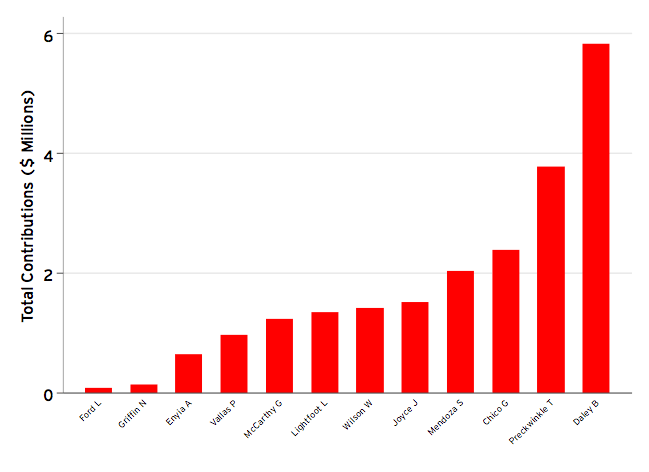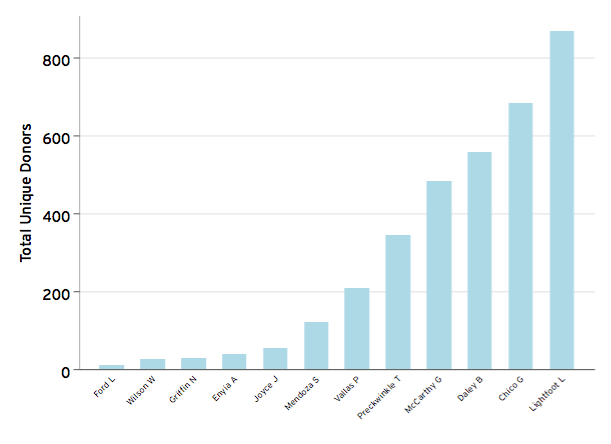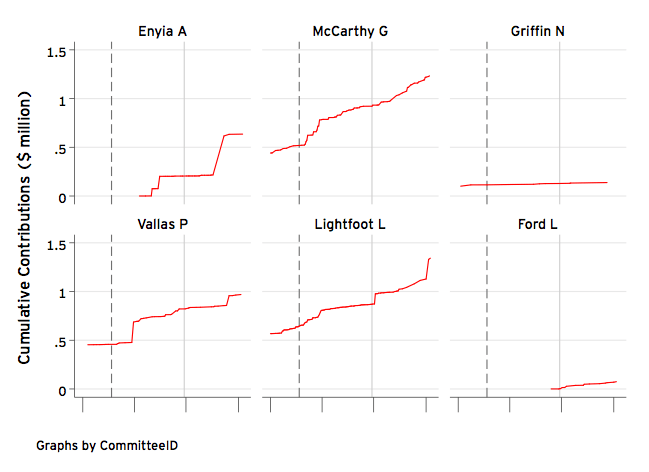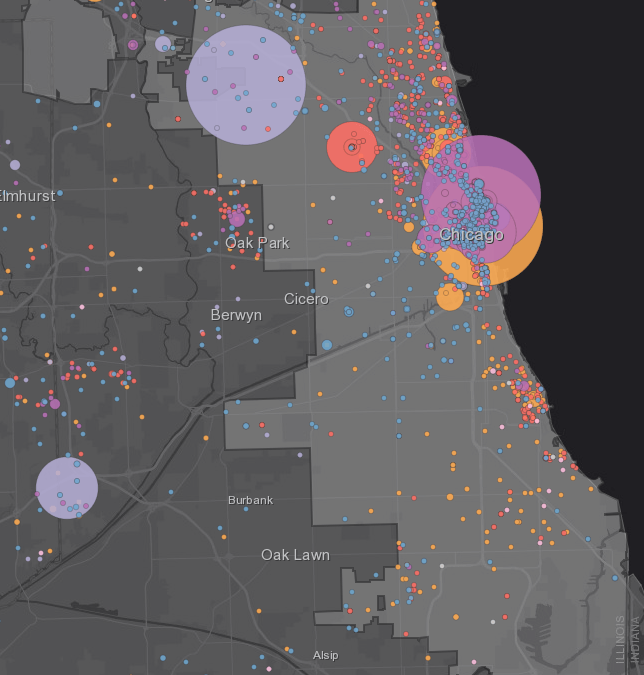(With Tom Ogorzalek)
Politics is awash in money these days, and the 2019 Chicago mayor’s race is no exception. The Illinois Board of Elections requires that candidates report on their campaign contributions, and examining data from their database reveals a surprisingly national web of donors to many candidates in the mayoral race. While this is understandable in a city connected in so many ways to the national and global economy, it is striking to see how dispersed and large the outside donations are. To see this, we collected contribution data for the 12 remaining candidates (current as of February 7) and mapped them out :
You can see at a glance the geographic dispersion of campaign funds, with money big and small flowing in from all over the map. You can take a closer look yourself and filter by candidate by visiting
this link. This post will examine broad patterns in the campaign’s money game so far.

Figure 2: Total contributions to each candidate to date.
Over $21 million has been raised so far by the candidates, with about $12.2 million coming from 2,900 contributions inside Chicago, $5.9 from 1,543 contributions from elsewhere in Illinois, and about $3.2 million from 767 contributions from outside the state. Daley, Preckwinkle, Chico, and Mendoza pulling in the biggest hauls. Much of their funds have been raised in large single donations, however: when we tally up how many unique donors have given to each candidate, the picture is a little different, with Lightfoot well ahead of the rest of the field. Because campaign contribution limits have been removed in this race, however, large individual contributors can swamp small-dollar donations.

Figure 3: Total unique donors for each candidate
How much of the contributions have come from outside the city limits? The map doesn’t lie, and the pattern of contributions varies across the candidates. Figure 2 shows how much each candidate has received from addresses inside Chicago, outside Chicago but inside Illinois, and Outside Illinois. Most candidates get lion’s share of their funds from the city (the red bars are generally taller than the others for each candidate). This is true in particular for Preckwinkle and Lightfoot, who have raised about 83 percent and 73 percent, respectively, of their campaign funds from within Chicago, reflecting a greater reliance on local ties (Wilson’s funds are 98 percent from Chicago, but that is all from his own address).

Figure 4: Campaign contributions by geographical source.
Daley, Chico, McCarthy, and Vallas each raise about half their money within the city limits, and the other half from outside. And Joyce’s war chest is filled largely from suburban address; among these is his wife, who is his largest donor. Again, Eniya’s CA connections provide the bulk of her reported fundraising to date.
Finally, we can take look at how the candidate’s funding has flowed in over time. Even before a ballot has been cast, this has already been an election season characterized by tectonic shifts in Chicago’s electoral landscape. First, Rahm Emanuel
opted not to run again, throwing the race into deep uncertainty. Then a series of scandals rocked the local Democratic organization, beginning with the early
morning raid of Alderman Ed Burke’s office by federal agents (a turn of events which resulted in an indictment and which is still unfolding
across the city’s political scene). Did these events affect candidates’ ability to raise funds? Theoretically, Emanuel’s departure increased the odds of victory for candidates then in the race, perhaps drawing money to their coffers; it also brought several leading candidates
into the race. Conversely, the Burke revelations may have scared away donors concerned about the viability of candidates connected to his spreading corruption scandal. Figures 5 and 6 examine these trends: The top panel includes the 6 leading fundraisers, and the second panel includes the next group (we’ve separated them because the scales are so different for the groups–notice that the top group goes up to $6 m and the other group to $1.4 m). Each of these subfigures shows the cumulative funds raised by each candidate over time. In each little figure, the dashed vertical line represents Emanuel’s announced withdrawal on August 4, and the grey vertical line represents the first raid on Burke’s office, on Nov. 29.

Figure 5: Cumulative contributions for each candidate over time: Top 6 fundraisers. Vertical lines indicate Emanuel’s announcement and federal raid on Burke’s office.

Figure 6: Cumulative contributions for each candidate over time: Fundraisers with less than $1.4 million. Vertical lines indicate Emanuel’s announcement and federal raid on Burke’s office.
Did these events have an effect on the campaign’s money game? Well, the most obvious thing is that most of the figures in the top panel weren’t even in the race before Emanuel dropped out, so that clearly had an impact on their decision to run. It would be interesting to consider what might have happened if Emanuel had stayed in–would the Daley and Preckwinkle money have flowed to his already-full coffers? Would it have gone elsewhere, or stayed in contributors’ pockets? For the candidates who are already in the race then, it seemed to represent a perceived opportunity to gain some ground. Lightfoot’s donations surged in September, as did McCarthy’s. Each candidate was receiving lots of small donations, but they quickly fell behind the late entries once those candidates began attracting huge dollar amounts. After the Burke raid, there were two significant blips: Preckwinkle received over a hundred donations totalling about a million dollars in the week following the raid, and has had much faster fundraising since the raid than before it. Lightfoot saw a bump in the days immediately after as well (though again, it’s all relative because of the disparities in magnitude), though it’s also true that she seems to do quite well at the end of each month. In general, though, even the unforeseen indictment of one of Chicago’s most powerful figures didn’t transform the money game, even if it did change the conversation toward more institutional campaign finance reforms.
While Preckwinkle is widely viewed as the most likely to at least make the second round, Daley is the money front-runner, and he has also been doing reasonably well in the early polling. This is perhaps surprising in a political moment in which change, reform, and populism seem to be in the air. After all, his biography–as son and brother of Chicago’s two longest-serving mayors, and Emanuel’s successor as President Obama’s chief of staff to boot–seems almost too perfect an embodiment of continuity with previous administrations. Based on the data here, he has evidently leveraged his national connections built from a career spent in finance and national politics, and melded it with his brother’s connections on the local scene, raising lots of cash both locally and from far-flung places.
As the political scientist Daniel Hopkins illustrates in his recent book
The Increasingly United States, American politics is nationalizing–that is, local elections are less local. The national fundraising networks shown in this election illustrate this fact. Hopkins argues that local politics is also less salient, but the big money at play suggest that people still care quite a bit about who becomes the mayor of this city, because of its size, economic importance, and the intensely contested issues at play. Money isn’t everything, though. Enthusiasm, strategy, organization, and issue positions will surely matter as well as we near the first round–and with this many candidates, there’s almost sure to be a second round in April. Even for candidates without major fundraising advantages, there are other valuable resources. In an upcoming post, we’ll look at how much candidates are using one tool that is widely available at a low cost–social media–as a tool in their campaigns. If you’re interested in learning more about campaign finance in Chicago and Illinois, check out further great work by the
Illinois Campaign for Political Reform.
Related







You must be logged in to post a comment.